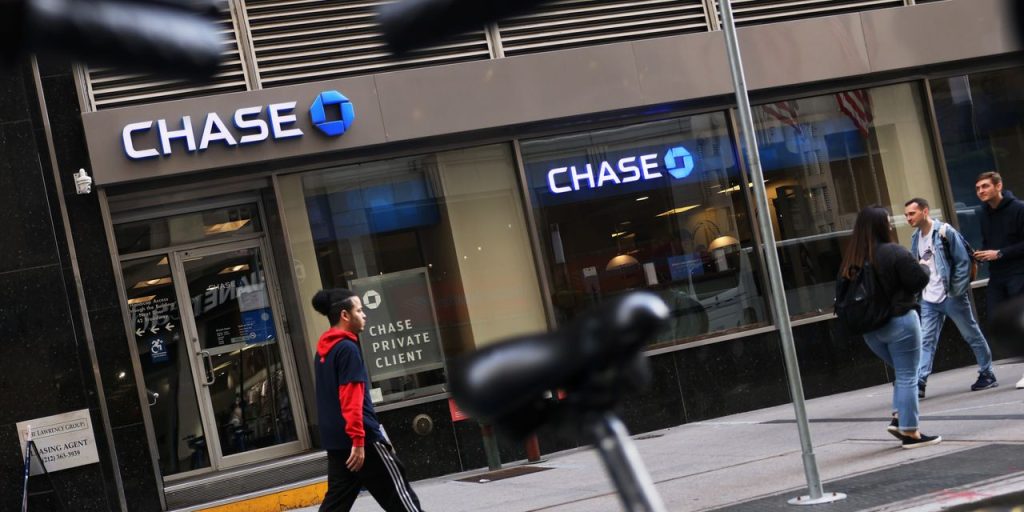The U.S. corporate earnings reporting season got off to a good start this week with large U.S. banks reporting robust first quarterly performance despite the collapse of Silicon Valley Bank and Signature Bank last month, but regional banks could still provoke some market volatility given their capital and liquidity issues when they report in coming weeks.
JPMorgan Chase
JPM,
+7.55%,
Wells Fargo
WFC,
-0.05%,
Citi
C,
+4.78%
and BlackRock
BLK,
+3.07%
all beat Wall Street’s estimates for their first-quarter profit, easing some of the markets’ concern that the sudden meltdown of two regional banks could send shockwaves across the U.S. banking sector and trigger additional financial problems to the economy that is already teetering on a cliff’s edge.
See: JPMorgan Chase stock moves positive for the year after it blasts past earnings and revenue estimates
JPMorgan shares ended 7.6% higher on Friday after the U.S. largest bank by assets, said its first-quarter profit rose to $12.62 billion, or $4.10 a share, from $8.28 billion, or $2.63 a share, in the year-ago quarter. Meanwhile, the chief executive officer of the bank said the economy still remains resilient.
“The U.S. economy continues to be on a generally healthy footing—consumers are still spending and have strong balance sheets, and businesses are in good shape,” Dimon said in a news release. “The storm clouds that we have been monitoring for the past year remain on the horizon, and the banking industry turmoil adds to these risks.”
Shares of Wells Fargo finished nearly flat, while Citigroup advanced 4.8% on Friday after both banks said first quarter net income and revenue surged from a year ago, demonstrating the resiliency of the so-called “goliath” banks amid the challenges that tested regional lenders in March. BlackRock’s shares surged 3.1% after the asset manager reported an 18% drop in first-quarter profit but beat analysts’ estimates.
“My biggest takeaway is the ‘goliath’ keeps winning and megabanks have benefited mightily from this recent banking ‘crisis.’ The net interest margin or the net interest income for both Wells Fargo and JPMorgan is up significantly,” said Milind Mehere, chief executive officer and co-founder of Yieldstreet.
“In the short term, they’re going to continue to benefit, and with rising interest rates, that’s going to benefit them as well. I think they’re in a good spot right now.”
Octavio Marenzi, chief executive officer at Opimas LLC, said market participants who have been looking for signs of cracks in the U.S. banking sector, were greatly relieved to not find any.
“Both Wells Fargo and JPMorgan delivered very, very solid results, blowing past the expected earnings,” Marenzi said.
Banks have also tried to steel themselves against potential loan losses on expectations for an economic slowdown later this year. JPMorgan said it shored up its reserves by a net $1.1 billion and booked another $1.1 billion in net loan charge-offs.
“They’re explicitly shoring up reserves from the previous quarter as well as from the previous year, which means that the bigger banks are preparing for the charge offs to come,” Mehere told MarketWatch in a phone interview on Friday.
See: Jamie Dimon discourages use of term credit crunch during earnings call with analysts
However, while mega-banks may have benefited from the issues with regional banks through the acquisition of deposits, the smaller banks will be facing tough questions around their liquidity profile and options.
“Because a lot of small and medium businesses rely on regional banks and community banks for their financing needs, any tightening that happens [to smaller banks] is going to impact them because they’re gonna have to go to higher cost options, or have to start cutting costs. And both of those scenarios are not good for the economy, and could potentially be a catalyst for the recession,” Mehere said.
See: Here are Goldman’s 4 things to watch for as gloomiest earnings season since pandemic begins
However, the weak performance of bank stocks since their recent meltdown could still stoke concerns that there is something wrong with this critical part of the U.S. financial system, as investors continue to gauge the probability of an upcoming recession, said some market analysts.
Nicholas Colas, co-founder of DataTrek Research, said it is a “worrisome sign” that the broader market has left bank stocks for dead since their meltdown in March.
While the S&P 500
SPX,
-0.21%
has risen 3.2% since March 8, when SVB first announced it had to sell all available-for-sale securities to strengthen its deteriorating financial position, the SPDR S&P Regional Banking ETF
KRE,
-1.95%,
which covers the regional banks segment of the broader S&P 500 index, has slumped 25.7%, according to Dow Jones Market Data.
Put in year to date performance terms, the S&P 500 index has advanced 7.3%, while the regional banking ETF is down 26.9%. “The damage done to this group by the March swoon has not started to reverse, even by a little bit,” wrote Colas, in a Thursday note.
However, Marenzi of Opimas LLC, said while these strong results are certainly good for banking sector stocks, they are going to paradoxically put pressure on the broader markets.
“Hopes that the Fed would have to start to reverse its interest rate hikes later this year, and boost the broader equities markets, to avoid tensions in the banking market have evaporated,” Marenzi said in emailed comments on Friday.
See: These 7 tables show just how bad this ‘crisis quarter’ could be for earnings of the 20 largest banks
U.S. stocks ended lower on Friday with the S&P 500 down 0.2%, while the Dow Jones Industrial Average
DJIA,
-0.42%
and the Nasdaq Composite
COMP,
-0.35%
each dropped around 0.4%. For the week, the Dow industrials booked four consecutive weeks of gains, while the S&P 500 gained 0.8% and the Nasdaq advanced 0.3%, according to Dow Jones Industrial Average.
Read the full article here




